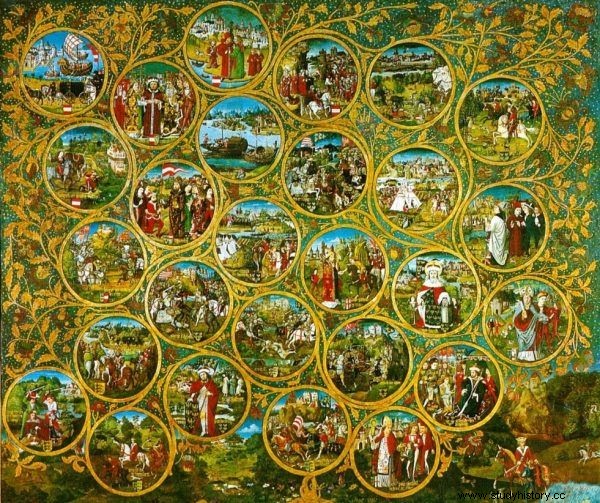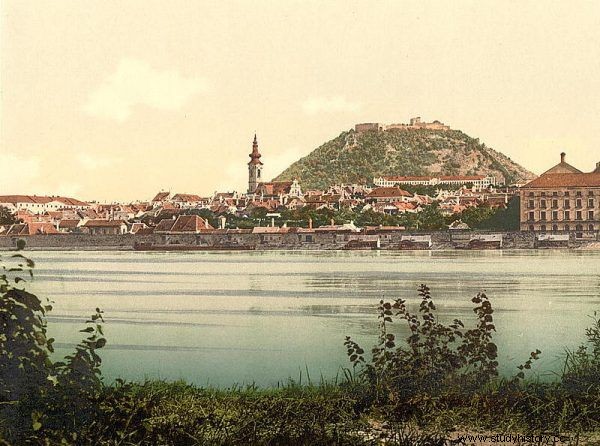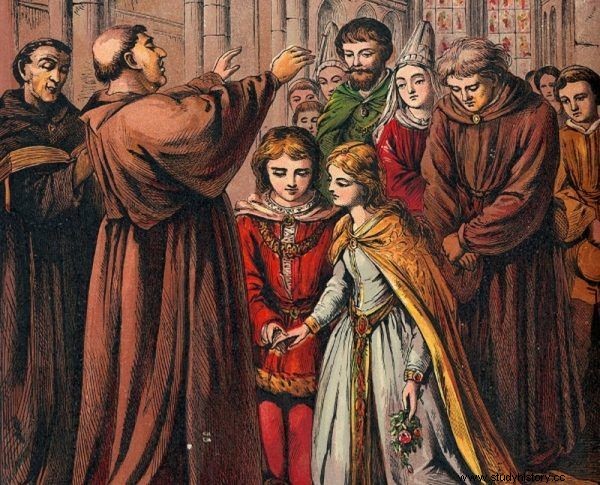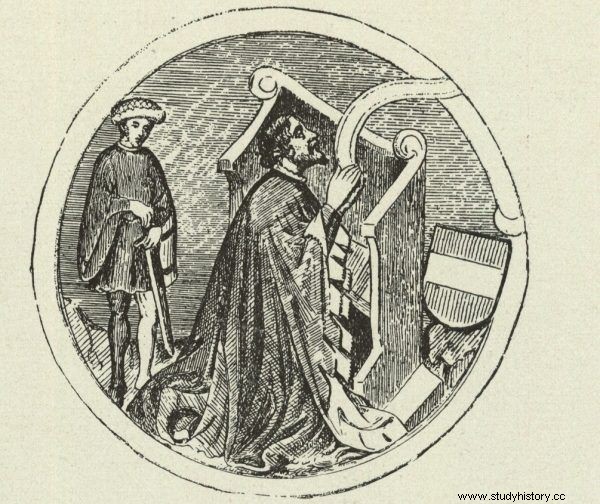Nobody asked her opinion and she was too young to understand what awaited her. It was not a joyful or even solemn moment. In addition, the groom at the decisive moment ... dirty the bed with feces.
Jadwiga was born in mid-February 1374. She was the third and last daughter of Ludwig of Hungary. An extraordinary ruler and not accidentally called the Great. Her father was in charge of one of the most powerful empires on the continent, so the girl did not have to wait long for the first bachelor to marry her.

Jadwiga probably didn't remember much about her first wedding night. The illustration shows a portrait of the ruler by Marcello Bacciarelli.
She was still whimpering in her cradle, and Austria's co-ruling prince Leopold III of the Habsburg dynasty had already begun to apply for her hand. As a married man in his thirties, he did not want to associate himself with a Hungarian baby. Instead, he wanted Jadwiga to become the bride of his four-year-old son, Wilhelm.
Second-class candidate
Today, the Habsburgs are associated with eminently cynical politics, with a network of influences encompassing the entire continent, and with the glitz of imperial power. It's easy to forget that their power was born relatively late. In the fourteenth century, they were still a dynasty in progress. They had only ruled Austria for a century and had to constantly remind their subjects that they were the legal heirs of the local Babenberg dynasty. They also had to bend their necks in front of the much more powerful and ruling just across the border Luxembourg, who owned the imperial throne at that time.

In the fourteenth century, the Habsburgs were a dynasty in the past. They constantly had to be reminded that they were the legal heirs of the Babenbergs. The picture shows the Babenberg family tree.
In a word, the Habsburgs were the second league in European politics. Louis the Great was, of course, aware of the importance of their relationship with them, but nevertheless quickly agreed to marry. He knew it would be hard to find a better candidate for Jadwiga. The girl was perfectly born, but she did not give her future spouse much except her pedigree. The Hungarian king had two kingdoms:Hungary and Poland. He was going to give them to his older daughters. Poland to Katarzyna and Hungary to Maria. There was no crown left for Jadwiga.
Leopold was well aware of this and accepted from the very beginning that the future daughter-in-law would not bring any dowry with her. He only asked Ludwik for help in the war waged in northern Italy, so as to carve out even a small state for the future bride and groom.
Wedding intercourse
The negotiations dragged on, probably not even out of ill will, but for the simple reason that Ludwik did not attach so much importance to the future of his third daughter. Leopold, meanwhile, crouched before him, as if it were at least a relationship with the Hungarian queen herself. When Ludwik finally announced that he had time to settle the matter, the Austrian immediately gave up all his duties. He was about to talk to the ruler of Burgundy about the marriage of his second son, but canceled the meeting, saying he was being held back by "urgent and serious negotiations."
Check where to buy "Ladies of the Polish Empire":
The negotiations took place in Hainburg, i.e. right on the Austro-Hungarian border. Today Hainburg is a small, slightly forgotten town a stone's throw from Bratislava. The motorway connecting the capitals of Austria and Slovakia does not pass here, so at most cyclists visit the town, following one of the two hiking routes. Even in the nineteenth century, traffic was incomparably greater. The main Austrian customs house was located in Hainburg. If someone went to the Habsburg fatherland by river, he could only go ashore here or in Vienna itself.
Above the city, famous for its tobacco production, there was a constant, pungent smell. The buildings were still surrounded by medieval walls, which in the era of technological progress served not so much as a protection against invaders, but rather as an additional means of protecting the market against the influx of smugglers. Hainburg is still dominated by, and still towers today, a massive fortress, remembering the times not only of Louis of Anjou, but even of Kazimierz the Restorer, who ruled in Poland in the 11th century.
It was in this castle that the King of Hungary and the Prince of Austria met in the early summer of 1378. The first of them was accompanied by four-year-old Jadwiga, and the second - eight-year-old Wilhelm. Plus, countless dignitaries, courtiers, servants, trained negotiators and ... bishops, just waiting for the matter to be resolved.

Hainburg in a postcard from the end of the 19th century.
In Hainburg, a ruling was signed regulating the conditions of the planned marriage, matters of dowry, dowry and inheritance. It was also decided that from now on Jadwiga would be brought up in Austria, under the supervision of her in-laws. However, it did not stop there. A wedding, a wedding ceremony and finally a wedding night took place at the border castle.
The prematurely matured princess
Child marriage was not uncommon in the late Middle Ages. Twelve-year-old girls had already entered into full-fledged weddings, treated by the law as adult women. In the case of boys, the crossbar was only slightly higher. Fourteen-year-olds were considered adults. But what if influential parents wanted to seal this or that political stratagem without waiting for their children to grow up a little?
A special variant of the wedding ceremony was created for their needs. In Latin it was called sponsalia de futuro . So a wedding for the future. At first glance, such a relationship differed little from an adult marriage. A service was organized, the bride and groom took an oath, then games took place. And only the last stage has been slightly modified.

Twelve-year-old girls had already entered into full-fledged weddings, treated by the law as adult women. In the case of boys, the crossbar was only slightly higher. Illustration and caption from the book "Ladies of the Polish Empire".
The spouses went to bed and possibly - gave each other one modest kiss. It was by no means expected that they would do anything more under the duvet.
These layers were purely symbolic. It wasn't until the girl was twelve and the boy was fourteen that they were to have sexual intercourse for the first time. This proper wedding night was the only act needed to legalize and consolidate the marriage. Along with the defloration, as emphasized by canon law experts, the relationship "for the future" became the relationship for now and the mortuary board. There was no need for any more celebrations, weddings or declarations. Only sexual intercourse.
Symbolic defloration
There were a lot of similar sponsorship. In the files of the French ecclesiastical courts of this era, even half of matrimonial matters concern relationships between children. However, the underage herds are especially favored by the Dynists. And it was them, kings, princes or barons, who gradually dismantled all legal objections.
In theory, a wedding, even a child's wedding, required at least an elementary understanding of the sacrament by those involved. That is why sponsalia were to be concluded between girls and boys of at least seven years of age. However, there was a way to limit this limitation. It began to be accepted that a child could stand on the wedding carpet earlier, as long as he had above-average intelligence and understanding of church rituals.
The exception, as is easy to guess, quickly became the rule. And it soon became apparent that the ruling families are home to a plethora of prematurely mature children. Boys barely out of the cradle were married, and girls who were just learning to walk were married.
4-year-old's wedding night
This was also the case with Jadwiga. It is difficult to talk about her supposed maturity at the age of four. There is also no point in claiming that the girl knew what her family really wanted from her. Father ordered, so she became William's wife.
Little more can be said about her wedding ceremony. It is known that it was a grand celebration; that Hainburg was bursting at the seams on this occasion, and the most important dignitaries from both countries escorted the bride and groom straight to the matrimonial bed.

Wilhelm Habsburg as an adult man. Illustration from the book "Ladies of the Polish Empire".
The symbolic wedding night, of course, took place in front of the witnesses. It was expected that the atmosphere would be elevated, and the bride and the bachelor, as expected, would jump under the duvet and in a modest but legible manner would show the audience that they were husband and wife. However, at least one of them failed to rise to the occasion.
The so-called Szamotuły Object , a very gossipy chronicle written at the beginning of the 15th century by an anonymous canon from Trzemeszno, states: Stratum Hedwigis turpiter concacavit . So:Prince William of the Habsburg family, probably not having control of his nerves and his sphincter, "disgustedly stained Jadwiga's bedding with feces."
The situation must have been awkward for the crowd, and for the prince, not so small as to pile up in diapers, outright compromising. However, it did not in any way affect the importance of the ritual. Documents confirm that the wedding was considered to have been concluded. And in 1378, nothing seemed to stand in the way of the union of Anjou and Habsburg.
Selected bibliography:
The article was based on materials collected by the author during the work on the book "Ladies pols what an empire. The Women Who Built a Power " . Some of these items are shown below. Full bibliography in the book.
- Donahue C., Law, Marriage, and Society in the Later Middle Ages. Arguments about Marriage in Five Courts , Cambridge University Press, Cambridge 2008.
- Donahue C., The Legal Background [in:] Marriage in Europe 1400–1800 , ed. S.S. Menchi, University of Toronto Press, Toronto 2016.
- Halecki O., Jadwiga Andegaweńska , Universitas, Krakow 2000.
- Kellog C., Jadwiga. Poland’s Great Queen , Macmillan, New York 1931.
- Lind G., Common Law Marriage. A Legal Institution for Cohabitation , Oxford University Press, Oxford – New York 2008.
- Mańkowski J., Birthday of Queen Jadwiga Andegaweńska and the day of her wedding with Władysław Jagiełło in the context of the blood act. Philologist's comments on the interpretation of sources , "Annals of the Lublin Genealogical Society", vol. 5 (2013/2014).
- Misiąg-Bocheńska A., Two dates in the life of Queen Jadwiga , "Polonia Sacra. Theological Quarterly ”, vol. 2, issue 3 (1949).
- Nikodem J., Jadwiga, King of Poland , Ossolineum, Wrocław 2009.
- Przybyszewski B., Jadwiga and Wilhelm , "Analecta Cracoviensia", vol. 7 (1975).
- Soszyński J., Complement Szamotuły [in:] Encyclopedia of the Medieval Chronicle , ed. G. Dunphy, C. Bratu, Brill 2016 (accessed September 22, 2017).
- Sroka S.A., Królowa Jadwiga , WAM, Krakow 2002.
- Wyrozumski J., Królowa Jadwiga. Between the Piast and Jagiellonian eras , Universitas, Krakow 2006.
